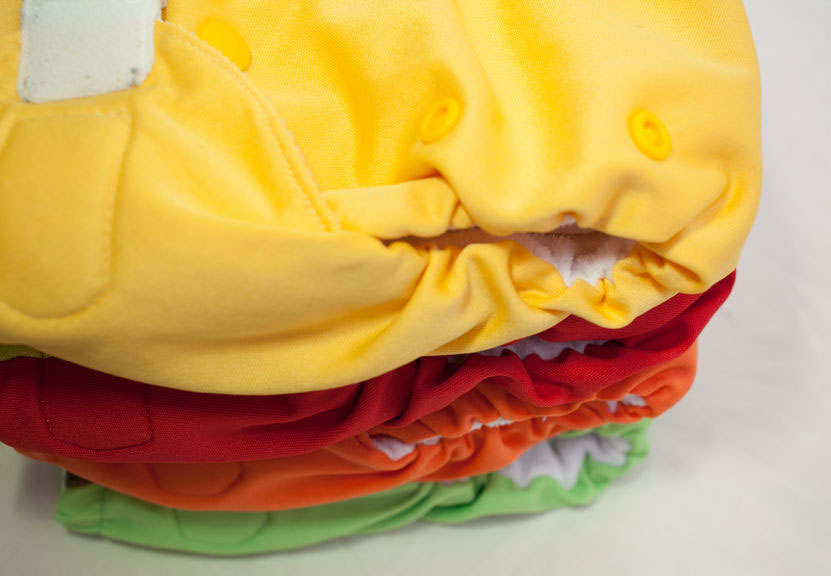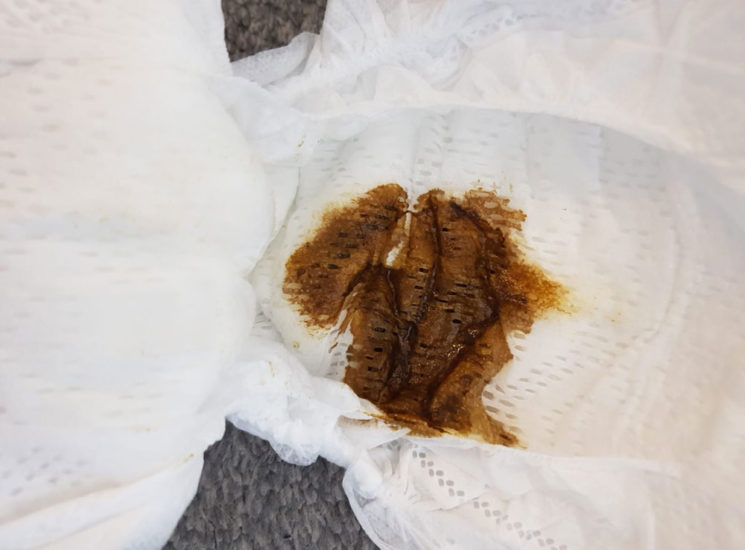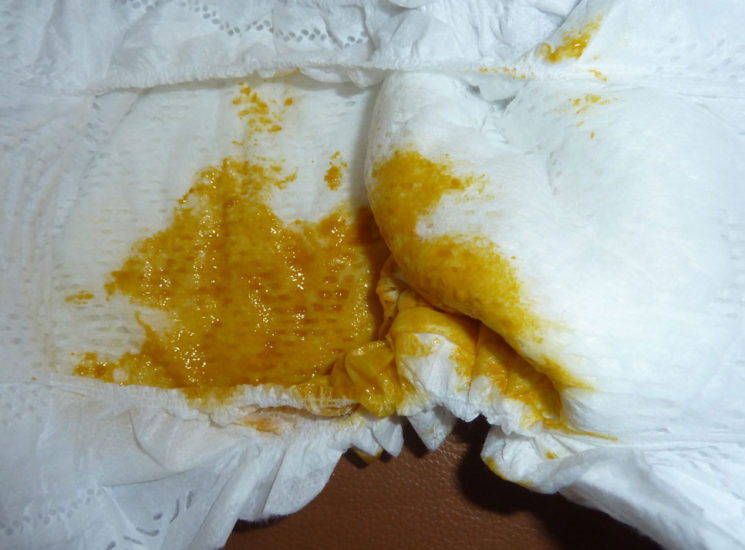What colour is a breastfed baby’s poop? How much poop should there be? Knowing the colour, consistency and amount of poop a breastfed baby produces in the early weeks can be very reassuring as it can provide clues about how breastfeeding is going and your baby’s health. This article looks at what to expect in your exclusively breastfed baby’s nappy during the first week of your baby’s life, weeks one to six, and after the sixth week.
Breastfed baby poop in the first week
Colour of poop in the first five days
The very first poop your baby passes on the first day of life is called meconium. Meconium is black, thick and sticky and will be passed in the first two days after birth. Over the next few days, breastfed baby poop tends to change through a predictable sequence of colours as the baby drinks more and more breast milk. The colour changes give a clue to how breastfeeding is going. When breastfeeding is going well, the colour of poop generally changes from black on the first day, to khaki green by the third day, then to brown and finally becomes yellow or mustard coloured poop by the fourth or fifth day. The stool consistency also becomes softer or more liquid and the number of poos per day gradually increases too.
- Day one—black poo, thick and sticky
- Day two—dark green/black poo
- Day three—greeny-brown (khaki) poo, getting runnier
- Day four—toffee brown poo
- Day five—yellow/mustard poo: soft and plentiful, at least three or four poops per day.
If you are not seeing these colour changes on these days, asking for early support with breastfeeding will help to make sure your baby is getting enough breast milk.
Number of poos
Reference books vary slightly on the average number of dirty nappies to expect each day in the first week. Lactation consultant Marsha Walker says to expect one poop on day one, rising to three or four on day three, and around four large (or ten small) poops by day four or five.1 Authors Wambach and Spencer say to expect two to four dirty nappies each day in the first two days, two to five dirty nappies each day between days three and four and anything between two and six dirty nappies each day between days four and seven.2 If you are not seeing plenty of dirty nappies, asking for support with breastfeeding will help check if a baby is getting enough breast milk.
Plenty of milk = plenty of yellow poop
The colour changes towards yellow poop, along with plenty of dirty nappies are a guide that your breastfed baby is drinking plenty of colostrum (the first secretion from the breasts after giving birth) and breast milk.34 However the nappy output is only one factor in the assessment of a baby’s calorie intake, health and well-being and it is important to have regular weight checks and be aware of all the ways to assess if a baby is getting enough milk (Wambach and Spencer, 2021).
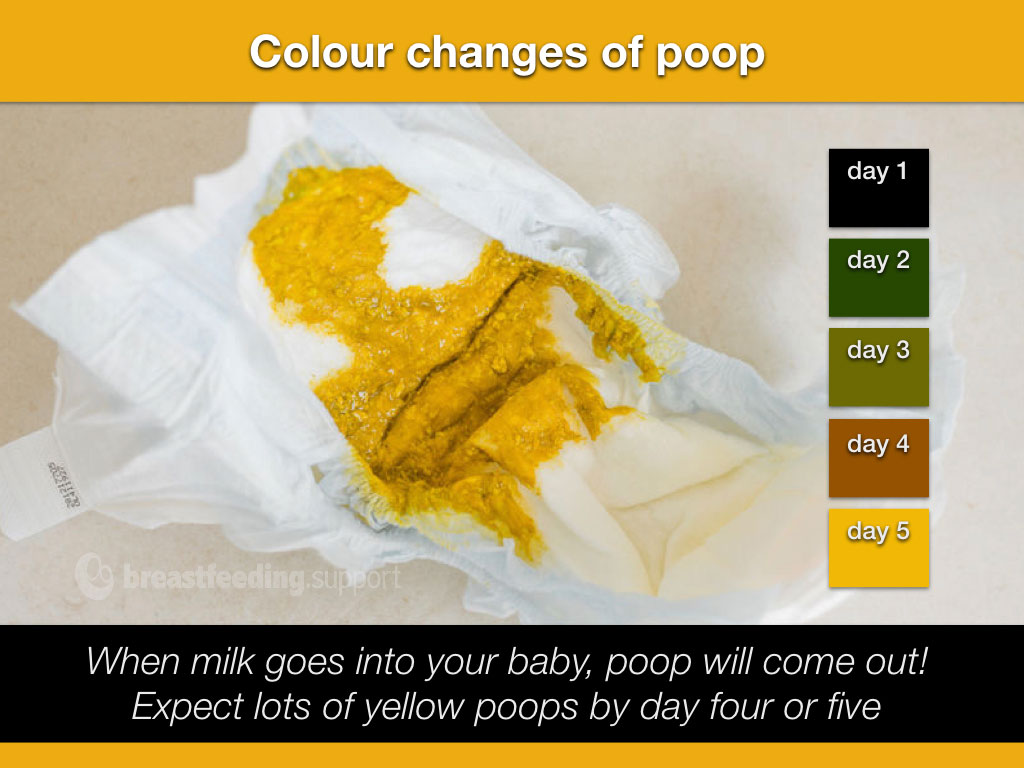
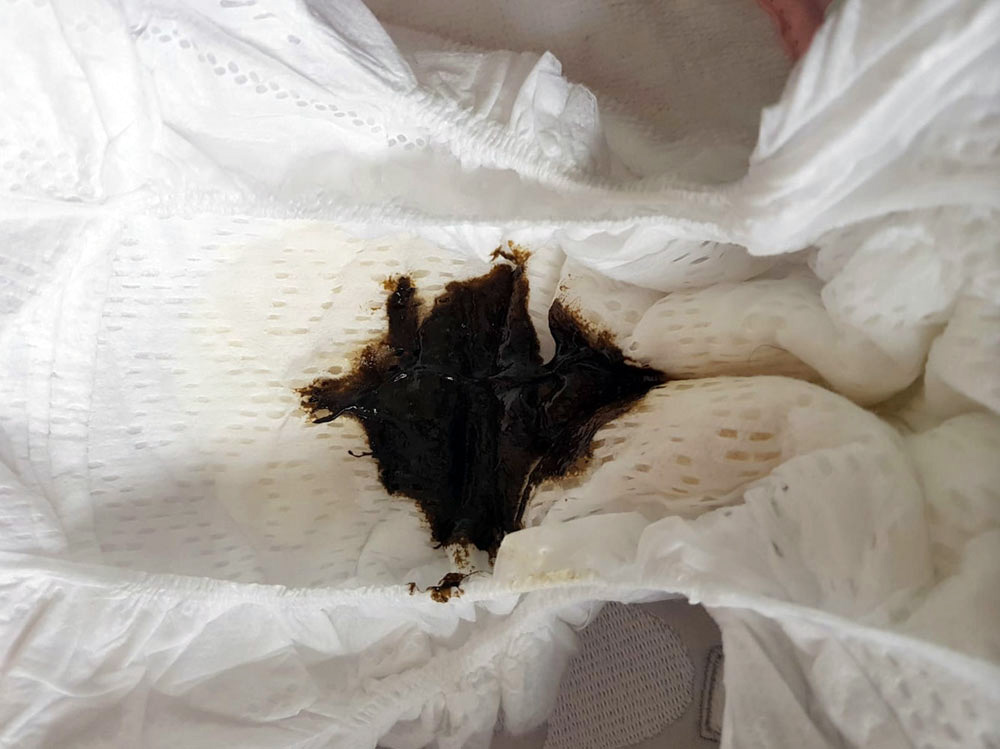
Weight loss and poop
During the first five days some babies lose a little weight, newborns can lose up to 7% of their birth weight in the early days of life and this is considered “normal”.5 When this happens, the daily colour changes in the nappy and the amount of poop can serve as reassurance that breast milk is being swallowed despite a little initial weight loss. However, if a baby continues to lose weight or is not gaining weight coupled with few or no poops, the most likely cause is they are not getting enough breast milk (Wambach and Spencer, 2021).
Breastfed baby not pooping?
If a baby is not having any dirty nappies the most likely reason will be that he is not getting enough breast milk and this needs urgent attention. The idea that a breastfed baby has no waste and therefore doesn’t poo very often in the first few days or weeks of life is not evidence-based. Wambach and Spencer recommend that if more than 24 hours pass without a stool in the first four to six weeks of life the baby should be seen by a health care provider and an assessment made of their milk intake (Wambach and Spencer, 2021).
Get breastfeeding help
Waiting around for poop without assessing how well a baby is breastfeeding can put a mother’s milk supply and baby’s health at risk. There are lots of reasons for a low milk supply and many ways to increase milk volume. If your baby isn’t having any dirty nappies (or not many per day), and if the colour hasn’t substantially changed by day four or five, check with your healthcare provider and call a breastfeeding specialist to check your baby’s latch, position, how often you are feeding and whether you are using one breast or two per feed. Watch your baby feeding carefully. If he doesn’t seem to be swallowing milk at the breast, expressing your milk will protect your milk supply and provide a supplement to feed your baby with until you can get help with breastfeeding.
Hold your baby
Kangaroo mother care and breastfeeding with skin-to-skin contact can help a baby breastfeed by optimising their feeding reflexes as well as encouraging frequent feeds. Keeping your newborn baby in your arms as much as possible may also help with more regular stooling. Nils and Jill Bergman explain that when separated from their mother, a baby’s stress hormones are released with the effect of decreasing digestion (and therefore stooling) to prioritise heart rate and breathing in basic survival mode.67
What about wet nappies?
When breastfeeding is going well you might expect to see at least one wet nappy on the first day of life followed by two to three on the second, three to four on the third, at least four to six wet nappies by the fourth day of life (Walker, 2017 p349) and at least five to six wet nappies per day by day five.8 Plenty of wet nappies are important to show that a baby is well hydrated. Wet nappies, however, are not a substitute for dirty nappies which can help indicate whether a baby is getting enough milk to grow as well as to stay hydrated in the first few weeks of life.9
How wet is a wet nappy?
It can be difficult to check for little wees in a disposable nappy as they are so absorbent. West and Marasco note clear urine usually means good hydration whereas more concentrated yellow urine may indicate dehydration.10
Reddish marks in a dry nappy?
In the first couple of days after birth, before a mother’s milk has come in, parents may spot orange or reddish “brick dust” marks in a baby’s nappy. These are known as “urates” or urate crystals and may be mistaken for blood. Check with your midwife and breastfeeding specialist as they may be a sign your baby is not getting enough milk. A little blood in the nappy of a baby girl may also be “pseudomenstruation” due to hormonal changes. Jack Newman, a Canadian paediatrician and breastfeeding specialist, has a Facebook post with a photo and more information about urates.
Breastfed baby poop—weeks one to six
Colour and consistency of poop
There can be a wide range of normal when it comes to colour and consistency. Breast milk contains traces of the mother’s diet. Therefore a mother’s diet or any medications she (or her baby) are taking could affect the colour and form of her baby’s poop.
- Colour. The usual colour of a breastfed baby’s poo by the end of the first week is yellow, mustard or light brown.
- Consistency. A breastfed baby’s stools are quite soft and unformed or runny and may contain small curds (Wambach and Spencer. 2021. p 263) that look like little lumps or seeds— see photo below. Authors Wilson-Clay and Hoover describe this as sometimes resembling yellow mustard or custard mixed with sesame seeds.11
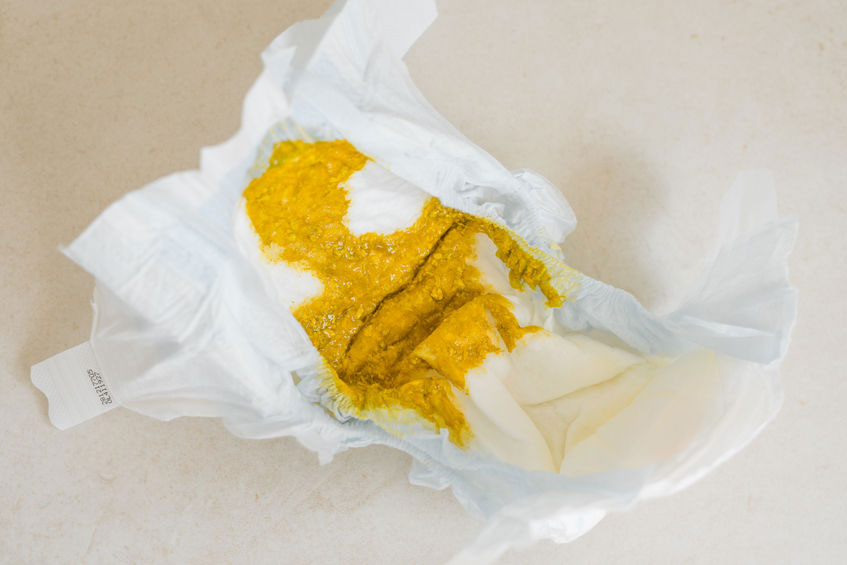
Green poop
Green poo is also common, it could be normal for your baby or have one of a number of other explanations. A baby with green poo may have an intolerance to something in his mother’s diet, be suffering from a lactose overload (green, frothy and foamy poop), not be getting enough milk or there may be another reason. See Why is My Breastfed Baby’s Poo Green?, Lactose Intolerance in Babies and Milk Allergy in Babies for more information.
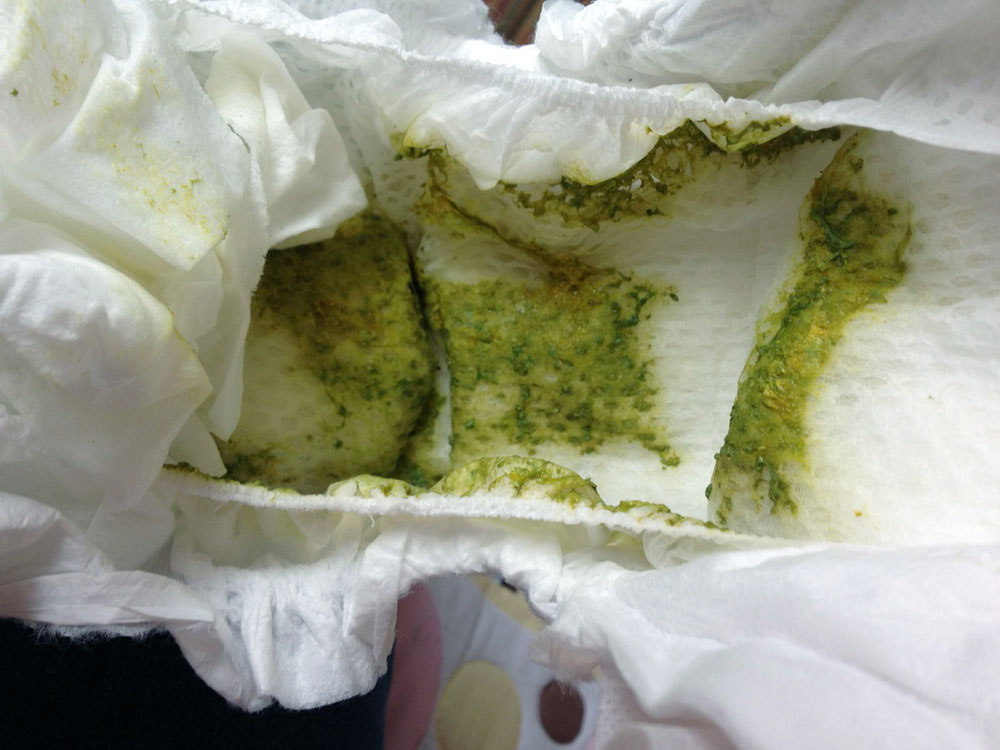
At least three or four poops per day
Expect frequent loose and copious bowel movements every day in the first four to six weeks (Wambach and Spencer, 2021) and five or six wet nappies per day. Frequency will vary between babies. The Art of Breastfeeding says babies who are growing well will have at least three poos each day in the first month that are at least 25-30mm or 1-1.5 inches diameter wide.12 Shrago et al suggest that well-fed breastfed babies will have four or more poos a day by two weeks of age.13 Dr Jack Newman says to expect anything between three and ten dirty nappies per day. He explains:
Usually during the first few weeks, exclusively breastfed babies will have many bowel movements every day. Ten a day is not rare and if the baby is content, drinking well at the breast and gaining weight, there is no issue. Furthermore, the amounts of each bowel movement and the colour can be quite variable. One day a baby could have 3 bowel movements, the next day 10 and 5 the day after. What matters is whether the baby is content and drinking well at the breast, not the colour of the bowel movements. Of course, the very dark green, almost black, bowel movements that are meconium are not normal after three or four days of life.
Baby not pooing
As in the first week of life, if your baby is not pooping frequently and/or weight gain is poor it is important to check whether baby is getting enough milk: see Is My Baby Getting Enough Milk? and contact your breastfeeding helper for a breastfeeding assessment. If baby is getting plenty of milk and gaining weight normally, less frequent stools may just be your baby’s rhythm—or see below for more possible reasons for infrequent stooling.
Breastfed baby poop—week six onwards
A breastfed baby’s pattern of dirty nappies can change around six weeks of age and they may start having fewer dirty nappies or not pooping every single day. Wambach and Spencer explain that the ratio of whey to casein (milk proteins) in breast milk changes slightly around six weeks resulting in slightly thicker more formed stools that may be passed less often although many patterns of stooling are possible (Wambach and Spencer, 2021 p263) Lactation consultant Robyn Noble says a breastfed baby over six weeks of age will typically have one copious mustard yellow poop per day with a consistency of toothpaste.14 Having fewer dirty nappies isn’t usually a concern at this age as long as weight gain continues to be good with plenty of wet nappies as before.
Very infrequent poos
Some breastfed babies may only stool once every three to ten days or so and their poo may be light brown due to a longer time in the gut. 15 The poop is usually soft and there’s plenty of it when it comes, so doesn’t fit the description of hard dry poop that may be described as constipation. However, although parents may be told that this interval between poops is normal in breastfed babies, it may not be ideal. A baby may be feeling uncomfortable after this period of time. Different authors have different explanations:
- Author Linda Palmer proposes that a potential cause of infrequent stooling, despite a good breast milk intake and weight gain, could be a sensitivity to cows’ milk products coming from the mother’s diet—especially if accompanied with rashes and other symptoms of allergy.16 See below for more information on how allergy can influence poops and flatulence.
- Lactation consultant Carol Smyth looks at a range of possible causes for infrequent stooling from medications to the microbiome in Should My Breastfed Baby Poo Every Day or is Breast Milk All Used Up?
- Authors Wambach and Spencer point out that health issues such as Hirschsprung’s disease, cystic fibrosis, infant botulism, cows’ milk allergy and other bowel disorders can be associated with unusual patterns (Wambach and Spencer, 2021). Parents should check with a healthcare provider if they have any concerns over unusual stooling patterns.
Difficulty pooping?
Some babies who seem to be uncomfortable when due to open their bowels may be helped to poop by holding them in a more upright seated position e.g. over a toilet or potty. Baby can be held securely with their back supported against a parent’s chest and with a thigh held in each hand in a supported squatting position. Gravity and freedom from a nappy can help a baby open his bowels.17
Constipation?
An exclusively breastfed baby’s poop is usually very soft and unformed. If stools are hard, dry and/or infrequent this may be diagnosed as constipation by your baby’s doctor. Constipation is more likely with formula-fed or mixed-fed babies18 and a switch to infant formula could cause firmer stools (Palmer, 2015, p179). Constipation can be associated with a food allergy19 or medical reasons such as a neurological disorder or even certain medication—reflux medication or iron supplements can cause constipation (Palmer, 2015; Smyth, 2016).
Food allergy and lots of poop
Situations that could be associated with food allergy described by author Robyn Noble in her book Breastfeeding Works! Even With Allergies include:
- Very frequent poop. Beyond six weeks of age, an unexpectedly high number of copious runny poops per day could be an indication of a food allergy affecting the gut. Other symptoms might include reflux, mucus or blood in the stools, or poor weight gain despite lots of poop.
- Smelly poop and/or flatulence (farts). Breastfed baby poop is usually described as inoffensive and has a characteristic sweet smell, sometimes described as yeasty or slightly cheesy (Wambach and Spencer, 2021). Unpleasant smelling poops, noisy bowel motions that are runny, frequent and gassy and/or excessive noisy flatulence (particularly after six weeks of age) can be associated with food allergy.
- Nappy rash. Frequent nappy rash and perianal burns (despite regular nappy changes) may be seen alongside food allergy because runny, gassy stools are more acidic and can burn a baby’s skin.
For more general information on food allergy see Milk Allergy in Babies.
The colour of poop
As with weeks one to six, the usual colour of breastfed baby poop before a baby starts solid food is yellow or mustard. Green coloured poop could be normal for an individual baby but there are also several other possible reasons, see Why is My Breastfed Baby’s Poop Green? Any concerns about the colour of your baby’s poop should be reported to your baby’s doctor and especially in the following situations:
Black poop
Very dark or black poop (other than the first few days of black meconium) could be a result of digested blood due to bleeding somewhere in the gastrointestinal system and should be reported to your health professional urgently. If a baby drinks a lot of blood stained breast milk due to his mother’s cracked nipples this may also cause very dark coloured poop, check with your health professional and see Blood in Breast Milk.
Red poop
If there is any bleeding lower down in your baby’s gut it may show as red streaks in your baby’s nappy as it won’t have had time to be digested. Traces of blood may be seen if a baby has allergic proctocolitis but there are other possible medical causes of bleeding. Report all cases of blood in the nappy to your doctor.
Pale or white poop, greasy fatty poop
Very pale or chalky white stools or stools that appear “fatty” or “greasy” should always be reported to your health professional. See What are the Symptoms of Jaundice? for further information.
Mucous in poop
Small lumps or strings of clear mucous may be seen in your baby’s nappy from time to time, mucous is produced in the bowel to lubricate the stool and is normal. But if there are frequent large amounts this may be due to some irritation in the intestines such as food allergy or sensitivity, an infection or it could be associated with other health issues—discuss with your doctor to rule out any concerns.
Unusual coloured poop
Unusual colours of an exclusively breastfed baby’s poop can be due to artificial food colouring, natural food pigments or medications in his mother’s diet.
After solids
Once solids are introduced, or formula, breastfed baby poop will change in appearance becoming browner, smellier and more like adult stools. Undigested food may sometimes be seen in the nappy (Wambach and Spencer, 2021). See Starting Solid Foods for more information.
Further reading
For a more in depth review of all the possible colours of baby poop and what they mean see Baby Poop: What Your Pediatrician May Not Tell You or visit the author’s website here. For a review of the content of this book click here.
Summary
The contents of your baby’s nappy can provide useful information about breast milk intake and your baby’s health alongside other signs that your baby is receiving plenty of milk. See Is My Baby Getting Enough Milk? and Baby Not Gaining Weight if you have any worries about how much breast milk your baby is having and seek the help of an IBCLC lactation consultant or breastfeeding specialist. Always report unusual colours of poop or any other concerns to your health professionals.
*Excerpts reprinted by permission of Pinter and Martin
